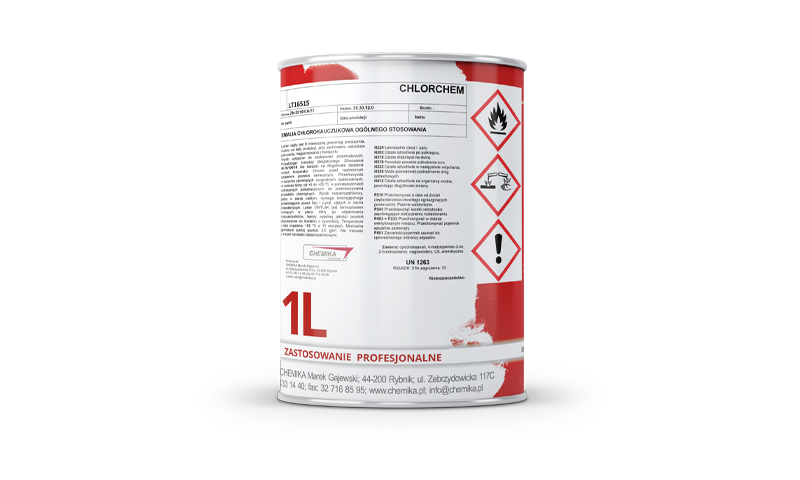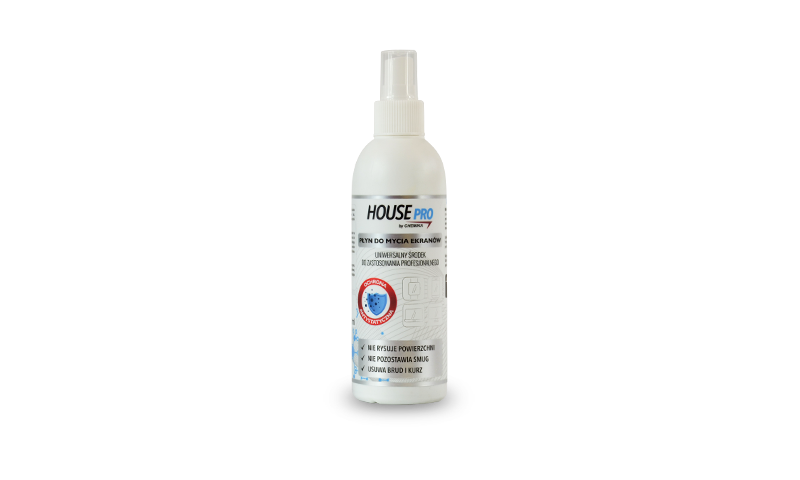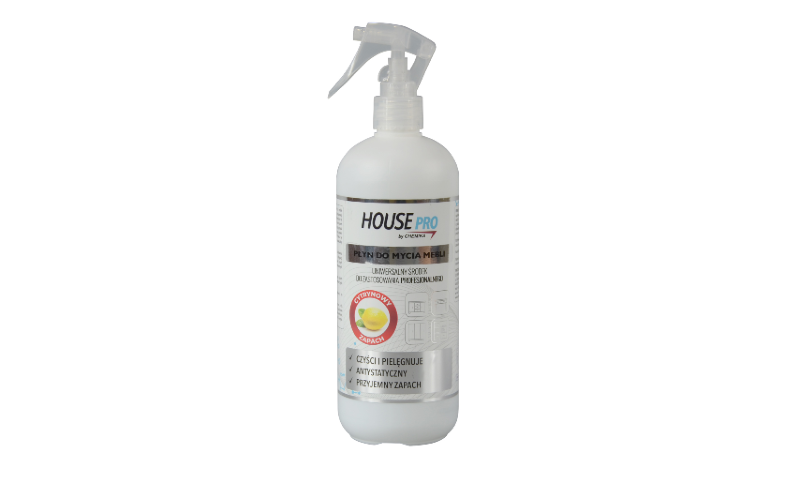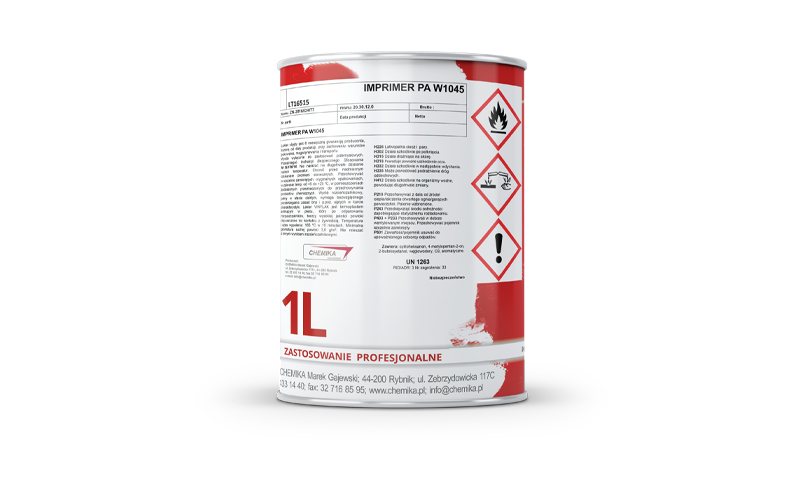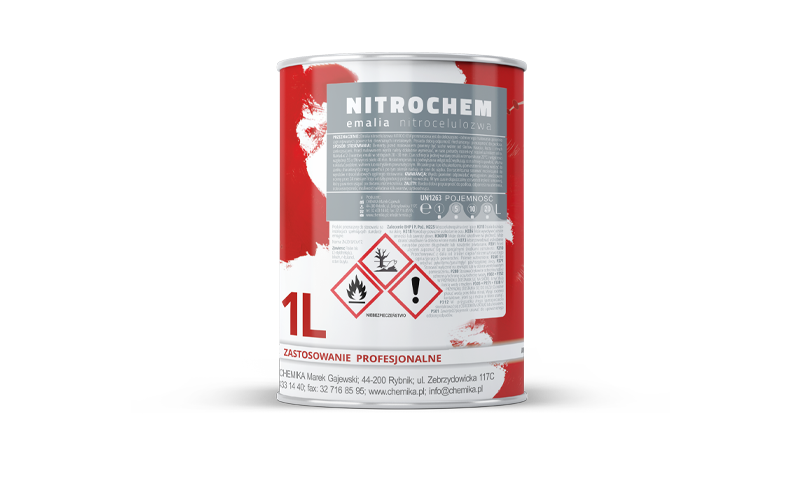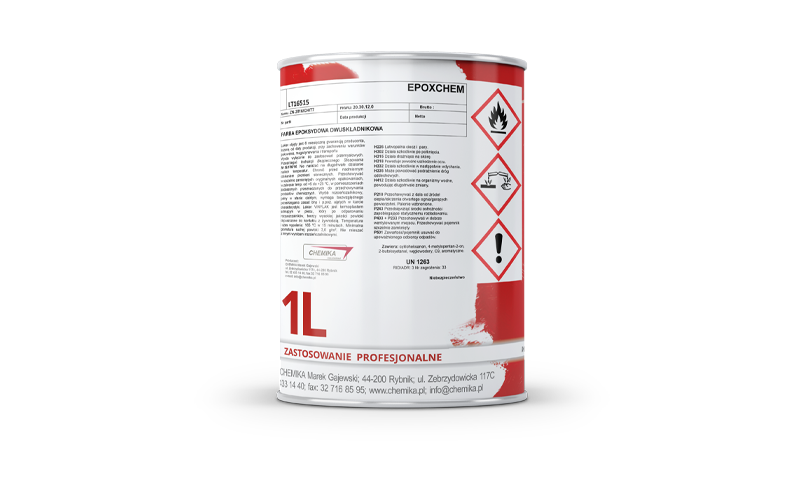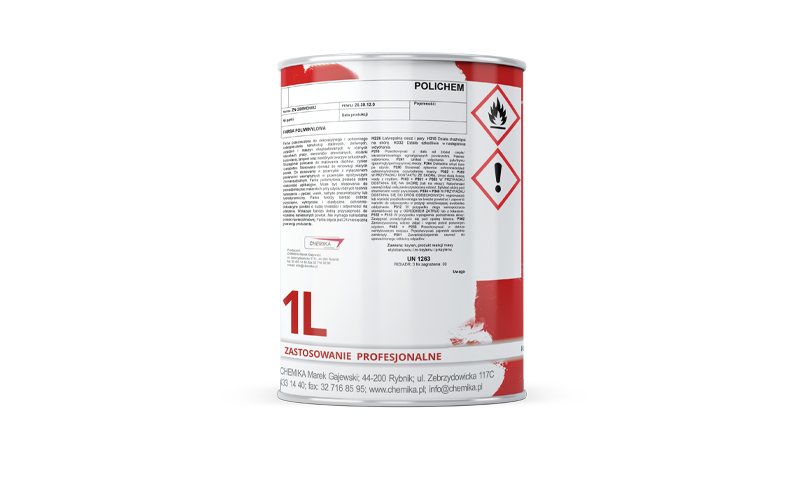Characteristics:
A suspension of pigments and fillers in an alkyd resin and chlorinated rubber solution
in organic solvents with the addition of driers, pigments, and auxiliaries. The enamel is available in a full range of colors, including those in accordance with the RAL color chart. The product is available in any color according to individual agreements with the customer. The product is solvent-based, flammable, and not intended for direct applications in explosion-prone areas. It is intended for painting work in ventilated rooms.
Product Properties:
Chlorinated rubber enamel has good application properties. It can be used for painting works using various application techniques – brush, roller, pneumatic spray, or hydrodynamic spray. Chlorinated rubber enamel is resistant to abrasion and creates strong, durable coatings with a high gloss. The enamel forms coatings with very good adhesion to substrates and primed and topcoated surfaces. The enamel coating also shows resistance to water, variable weather conditions, and mechanical damage.
Intended Use:
Chlorinated rubber enamel is intended for the protective coating of metal or cast-iron devices and structures, concrete, lime and cement plasters, wainscoting, and certain plastics. It can be used for exterior and interior painting, especially in residential areas, healthcare, educational and welfare facilities, offices, and other public utility buildings. It is also excellent for decorative painting. The enamel requires the application of a primer. For use in industries, excluding internal surfaces in the food and pharmaceutical sectors.
Application Method:
Before starting painting works, the enamel should be well mixed and, if necessary, diluted with a chlorinated rubber product thinner to achieve the required working viscosity, adjusted to the chosen application method. Application methods – brush, roller, pneumatic spray, or hydrodynamic spray. The enamel should be applied to degreased, dust-free surfaces. The surface to be painted should be dried, cleaned of loosely adhering rust, old peeling paint, dusted, and degreased using a solvent. The minimum temperature of the painted surface should not be lower than +5 ºC and 3 ºC higher than the dew point. Painting should be done at a temperature of the painted substrate not exceeding 35 ºC. The maximum relative humidity of the air during painting work should not exceed 85%. The recommended thickness of the dry coating is 30-35 µm. It is recommended to apply 1 to 2 layers.
WARNING: Before starting work with the product, please familiarize yourself with the product's safety data sheet. The product is solvent-based, flammable, and requires strict compliance with occupational health and safety (OHS) and fire protection regulations during use. Application Method Recommended Viscosity (Ford cup No. 4) /s/
| Brush, roller | 60-110 |
| Pneumatic spray | 25-40 |
| Hydrodynamic spray | 40-90 |
Conditions During Painting Work:
Apply the enamel in well-ventilated or aired rooms. Electrical devices should be explosion-proof. The product should be used in accordance with safety regulations, particularly those concerning occupational health and safety and fire protection, as outlined in the safety data sheet. During the application, do not eat, drink, or smoke, and work away from sources of flame. Painting work should be conducted at ambient temperatures not lower than +5 ºC and not higher than +35 ºC, with a maximum relative humidity of 85%. The optimal air temperature during painting work is between +15 ºC and +30 ºC. The best results are obtained when painting at a relative humidity of air below 80%. An increase in humidity above 80% creates favorable conditions for the formation of a layer of absorbed water on the surface, which may reduce the adhesion of the coating to the painted surface.
Transport:
The enamel should be transported in original, tightly closed packaging. The paint is subject to regulations concerning the transport of hazardous goods. It is classified as a hazardous material and subject to transport regulations according to RID/ADR (UN material identification number 1263, classification code/class – 3/F1, packing group III, hazard identification number 30).
Storage:
The enamel should be stored in cool, dry, well-ventilated rooms, away from direct sunlight, sparks, and heat sources. The storage area should be protected from static electricity, for example, by grounding. Protect from overheating and excessive exposure to sunlight. The storage area should be well-ventilated and intended for hazardous material storage. Ventilation and electrical installations should be explosion-proof. The enamel should be stored at temperatures between +5 ºC and +25 ºC, in enclosed rooms that ensure sufficient protection, away from food, feed, and food containers, and in places inaccessible to unauthorized persons. Do not expose to prolonged low temperatures.
Warranty Conditions:
The enamel is covered by a 24-month warranty from the production date. An increase in the agreed viscosity during this period is acceptable, which should resolve with the addition of a chlorinated rubber product thinner. The product will be replaced if packaging, storage, and transport conditions have been maintained, and defects that prevent the use of the product for its intended purpose arise from the production process and are the manufacturer's fault.
Selected Technical Parameters:
| Density | max. 1.35 g/cm3 |
| Viscosity (Ford cup No. 4) | 60 ÷ 110 s |
| Cover quality, degree | 2 ÷ 3 |
| Gloss | matte, gloss, semi-gloss |
| Thinning | thinner for chlorinated rubber and vinyl products |
| Cleaning tools | immediately after use with thinner |
| Volatile content | 41% by weight |
| Coverage | 8-10 m2/l per layer |
| Substrate temperature | not lower than 5 ºC, 3 ºC higher than dew point temperature |
| Ambient temperature | not lower than 5 ºC (optimal above 10 ºC) |
| Application methods | hydrodynamic spray, pneumatic spray, brush, roller |
| Recommended number of layers | 1 to 2, depending on the achieved thickness |
| Drying time of the coating [at 20±2 ºC and 55±5% relative humidity] |
degree 1 – 4 h degree 3 – 18 h |
| Time to apply the next layer at 20 ºC | 18 h |
| LVOC limit (cat. A/i/FR=500 g/l) STEP II |
max. 480 g/l |
| Tested parameters may change with changes in environmental conditions, layer thickness, and number of layers | |
Factory standard No. ZN-2012/CH/47 in accordance with PN-C-81608:1998.
Has PZH certificate No. HK/B/1072/02/2017.

